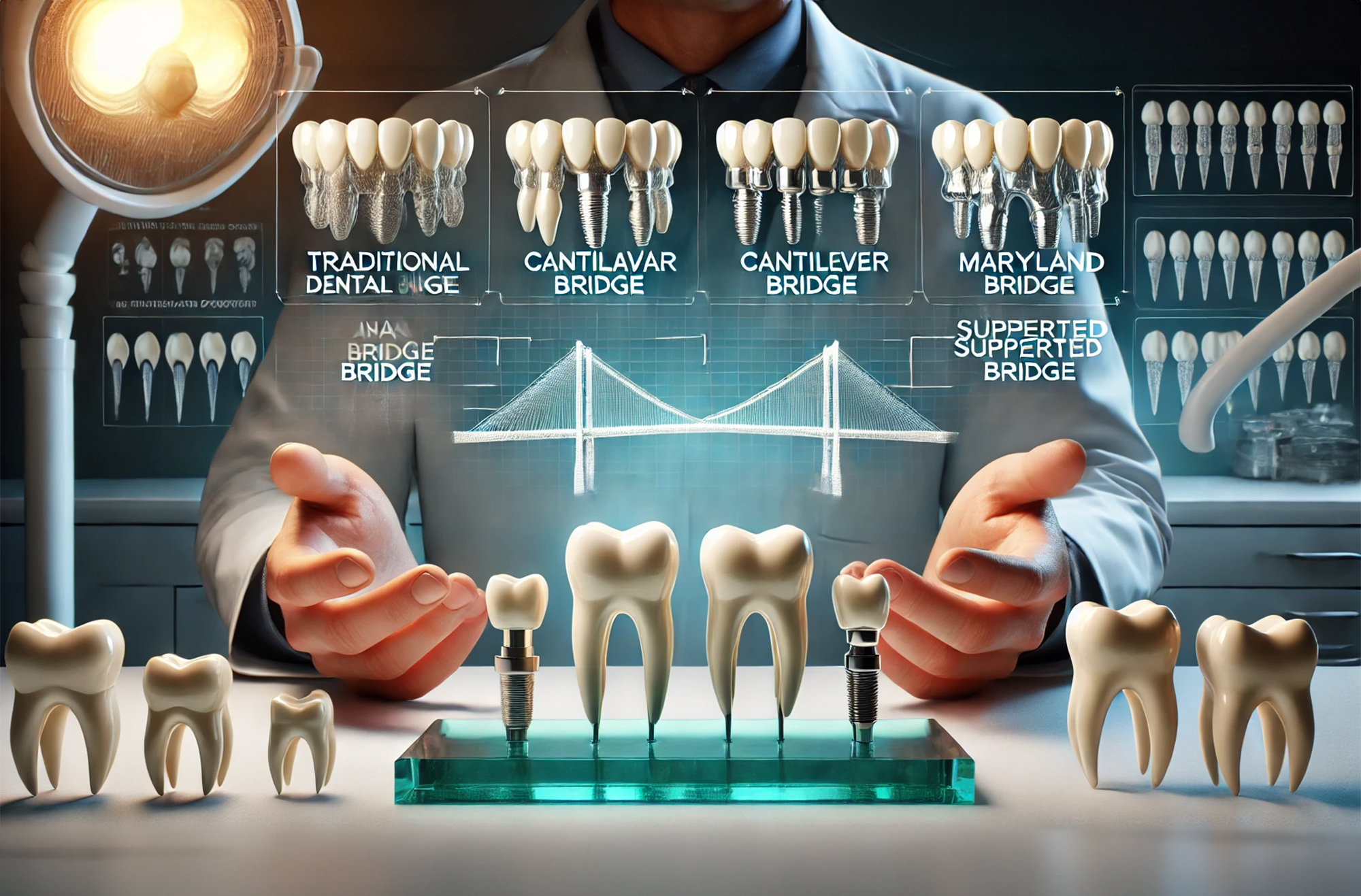The Different Types of Dental Bridges: A Comprehensive Guide
Dental bridges are a common and effective solution for replacing missing teeth, helping to restore both function and aesthetics to your smile. Understanding the different types of dental bridges available can help you make an informed decision about which option is best for your oral health needs. In this blog, we will explore the various types of dental bridges, their benefits and drawbacks, and the scenarios in which each type is most commonly used.
What is a Dental Bridge?
A dental bridge is a prosthetic device used to replace one or more missing teeth. The bridge consists of one or more artificial teeth (called pontics) that are anchored in place by natural teeth or dental implants on either side of the gap. Dental bridges help to restore chewing function, maintain the shape of the face, and prevent remaining teeth from drifting out of position.
Types of Dental Bridges
- Traditional Dental Bridges
- Structure: Traditional bridges are the most common type and consist of one or more artificial teeth held in place by dental crowns cemented onto the adjacent natural teeth, known as abutment teeth.
- Use Case: This type of bridge is ideal when there are healthy teeth on either side of the missing tooth or teeth.
- Pros: Provides strong support and a natural appearance. They are durable and can last many years with proper care.
- Cons: Requires the preparation (shaving down) of the adjacent teeth to accommodate the crowns, which may compromise the integrity of healthy teeth.
- Cantilever Bridges
- Structure: Cantilever bridges are similar to traditional bridges but are supported by a dental crown on only one side of the missing tooth or teeth.
- Use Case: Typically used in areas of the mouth where there is only one natural tooth adjacent to the gap, such as the front teeth.
- Pros: Useful when there is only one adjacent tooth to support the bridge.
- Cons: Since the bridge is only supported on one side, it may act as a lever and put additional stress on the supporting tooth, increasing the risk of damage.
- Maryland Bridges (Resin-Bonded Bridges)
- Structure: Maryland bridges use a metal or porcelain framework bonded to the back of the adjacent teeth. The pontic is then attached to this framework.
- Use Case: Often used to replace missing front teeth where the forces are less than in the back of the mouth.
- Pros: Minimally invasive, as it doesn’t require the removal of much enamel from the adjacent teeth.
- Cons: Less durable than traditional bridges and can become loose over time. It also may not be suitable for areas of the mouth that experience high bite pressure.
- Implant-Supported Bridges
- Structure: Instead of being supported by natural teeth, implant-supported bridges are anchored to dental implants. An implant is surgically placed for each missing tooth, and these implants support the bridge.
- Use Case: Ideal for patients missing several teeth in a row or those who do not want to rely on adjacent teeth for support.
- Pros: Very stable and durable, with a natural look and feel. They do not require the alteration of healthy teeth.
- Cons: Requires surgery to place implants, which can be more expensive and time-consuming. The healing process can take several months.
Benefits of Dental Bridges
- Restores Functionality: Dental bridges restore the ability to chew and speak properly, which can be affected by missing teeth.
- Aesthetic Improvement: Bridges fill in gaps left by missing teeth, enhancing the appearance of your smile.
- Prevents Teeth from Shifting: Filling the gap prevents adjacent teeth from moving into the empty space, which can lead to misalignment and further dental issues.
- Long-Lasting Solution: With proper care, dental bridges can last anywhere from 5 to 15 years, depending on the type and materials used.
Considerations When Choosing a Dental Bridge
When deciding on a dental bridge, several factors should be taken into account:
- Location of the Missing Tooth: The location will determine the type of bridge that is most suitable. For example, traditional bridges are often used for molars, while Maryland bridges are more suited to front teeth.
- Health of Adjacent Teeth: If the adjacent teeth are healthy and strong, a traditional or cantilever bridge might be a good option. If not, an implant-supported bridge may be recommended.
- Cost and Insurance Coverage: The cost of dental bridges can vary widely depending on the type and materials used. It’s important to check with your dental insurance provider to see what is covered.
Conclusion
Dental bridges are a versatile and effective solution for replacing missing teeth, offering both functional and aesthetic benefits. By understanding the different types of bridges and their respective advantages and drawbacks, you can make an informed decision about which option is best for your oral health. At Quadro Dental, we offer a range of dental bridge options tailored to meet your specific needs. Contact us today to schedule a consultation and take the first step towards restoring your smile.
Please contact us directly on WhatsApp to schedule a free consultation.
